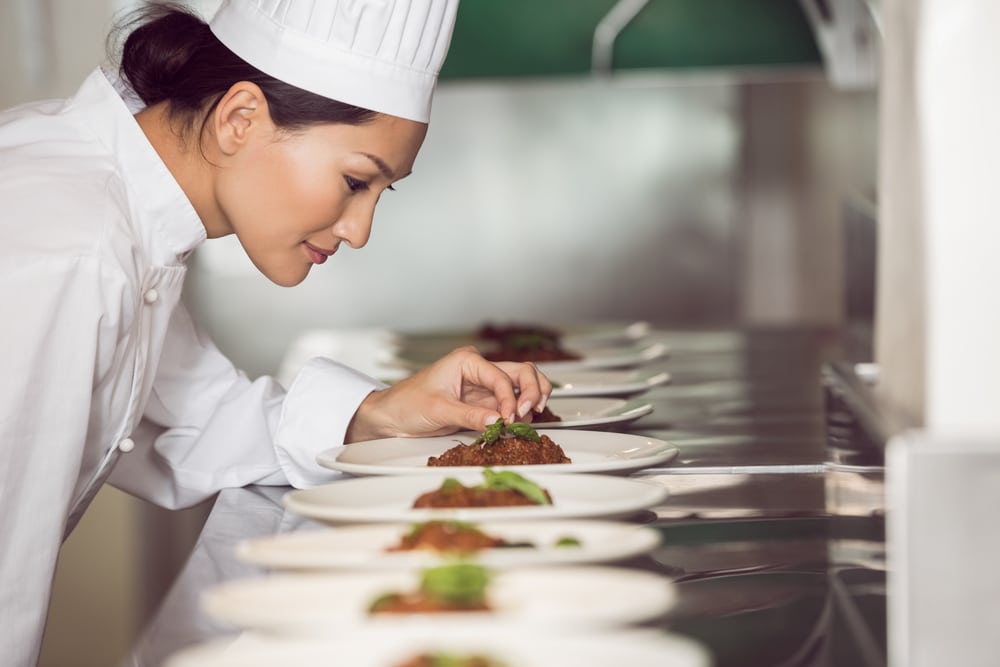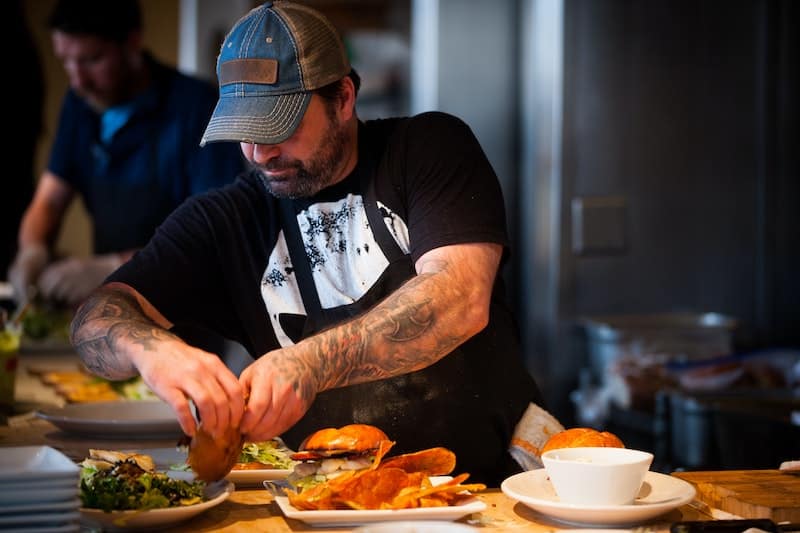While customers rarely, if ever, interact with the cooks in your quick-service or fast casual restaurant locations, you know that what they’re really there for is the food! Well-trained prep and line cooks are as much a part of a consistent and enjoyable customer experience as your customer-facing employees, and so proper line and prep cook training is vital for your restaurant business.
The difference between a prep cook and a line cook is that a prep cook works on preparing ingredients ahead of time, while a line cook works during service to perform cooking tasks. The prep cook works off of a par sheet to make sure the line cook has the ingredients they need.

Line cook responsibilities and training
Line cooks are responsible for cooking and preparing your menu items, either according to order or in large batches to accommodate quick service times. Line cooks typically work in a fast-paced environment and must be able to multitask effectively and work well under pressure. They should also have strong communication and teamwork skills, as they will be working closely with other kitchen staff to prepare and cook dishes.
Thankfully, if the responsibilities of the prep cook are well-executed, the line cook really will only have to worry about one main job: preparing the food that the customers are craving. Here are some of the things that you’ll want to cover when training your line cooks, both during your restaurant employee onboarding and during ongoing training:
- Familiarity with the kitchen setup, equipment, and how people will be navigating through the space
- Following recipes and cooking instructions accurately to ensure that dishes are prepared to the required standards, and consistently across all your locations
- Monitoring the cooking process to ensure that dishes are cooked to the correct temperature and are ready to be served while following food safety guidelines
- Plating and assembling finished dishes for service, ensuring that they are presented attractively and according to the restaurant’s standards
- Maintaining a clean and organized work area, including washing and sanitizing equipment and surfaces, and maintaining cooking equipment
- Communicating with other kitchen and front-line staff to coordinate the flow of orders and ensure that dishes are prepared in a timely manner
- Ensuring that all food safety and sanitation guidelines are followed
This training list is essential to what your line cooks will be expected to do on a day-to-day basis, but it will definitely look different depending on your specific restaurant’s needs. It is vital to hire the right personality for these roles. A cool-headed person who works well under pressure and can manage various tasks at once will be an easy team member to train and transition into your kitchen.
Prep cook responsibilities and training
The training required for a prep cook will depend on the specific needs of the restaurant and the level of experience and skill desired for the position. Some prep cooks may have completed formal culinary education, while others may have learned their skills through on-the-job training or apprenticeships. In most quick-service and fast casual restaurants, the prep cooks are more of an entry-level position to get someone started working in a kitchen.
Regardless of the specific training path, prep cooks should have strong technical skills, good communication and teamwork skills, and the ability to work well under pressure. While your store manager primarily manages the relationship between suppliers and the business, a prep cook may help to manage the logistical flow of ingredient inventory, ensure food safety standards are met, and communicate with managers when things are running low.
Because the prep cook is most closely working with ingredient inventory and supplies, there are several tasks and responsibilities that may be best to train them on. This responsibility may be given to someone else in your organization, but generally the prep cook is a good candidate for helping with the inventory management of the ingredients and supplies they prepare on a day-to-day basis.
Here are some of the inventory management tasks they may need to be trained on:
- Accepting, labeling, and properly storing deliveries
- Properly organizing supplies by date within the refrigerator/freezer/pantry to ensure waste is minimized and local regulations are followed
- Ensuring proper food safety and temperature guidelines are followed to avoid any health risks
- Breaking down bulk items into manageable containers for easier storage and access
- Distributing inventory to appropriate cook stations
- Tracking when inventory is low and reporting to the store or shift manager
- Understanding seasonality to know when certain ingredients may be required more or less than usual
- Utilizing inventory management software solutions to ensure proper accounting, analytics, and purchasing.
The most common responsibility of the prep cooks is to take the bulk ingredients that are commonly used in the menu items, and prepare them for easy use by the line cooks. Generally speaking, this involves a ton of chopping and dicing, and then stored in the appropriate containers for use throughout the day. Some ingredients may also need to be prepared for several days at a time.
What this looks like varies wildly between different restaurant chains, and is completely dependent on the type of food you cook and what your menu actually consists of. For instance, the preparation of ingredients for a soup-and-salad restaurant would be completely different for a bakery or coffee shop.
Some of the many possible responsibilities of your prep cooks include:
- Washing produce
- Peeling produce if the skin is undesirable
- De-seeding produce if needed
- Cutting produce and other ingredients to an appropriate size according to specific dishes (julienne style, sliced, etc.)
- Defrosting meat/fish/mollusks/crustaceans
- Removing excess fat, bones, etc. from meat ingredients
- Breading food for frying/baking
- Creating portion pastes, basic sauces, and pasta for dishes
- Making dough for baked or fried pastries and breads
- Organize dish stations and ensure cleanliness and maintenance of cooking equipment
- Ensuring the entire restaurant is stocked, from the kitchen to the utensils, and even the bathroom
To properly train your prep cooks, you need to have a clearly detailed outline of what their responsibilities will be. Then you can adapt your restaurant training manual to match.

Day in a Life of Prep Cook: Working in a Michelin Recommended Kitchen
FAQ
Is it better to be a prep cook or line cook?
Is prep cook below line cook?
What is a prep cook?
What is the difference between a cook and a line cook?
What is the difference between a prep cook and a line cook?
Line cooks are more experienced and often higher trained member of kitchen staff than a prep cook. The prep cook prepares the ingredients that the line cook then uses when cooking the meals at the restaurant. Becoming a line cook may be a natural next step for prep cooks when advancing in their careers.
Why is a line cook higher in rank than a prep cook?
A line cook is higher in rank than a prep cook because of the higher responsibility that a line cook has to the restaurant. Line cooks are more experienced and often higher trained member of kitchen staff than a prep cook. The prep cook prepares the ingredients that the line cook then uses when cooking the meals at the restaurant.
Do line cooks have more responsibility than prep cooks?
Line cooks have more responsibility than prep cooks. Line cooks typically have more culinary experience and are usually more highly trained than prep cooks. Prep cooks often prepare the ingredients that line cooks use when cooking meals. Many line cooks have previously worked as prep cooks.
What does a line cook do in a kitchen?
Here are some tasks that a line cook might perform in a kitchen: Cook menu items in coordination with the head chef and other line cooks Comply with nutrition and sanitation regulations and standards What is a prep cook? A prep cook is a kitchen staff member who handles prepping the ingredients for all the dishes served at the restaurant.
